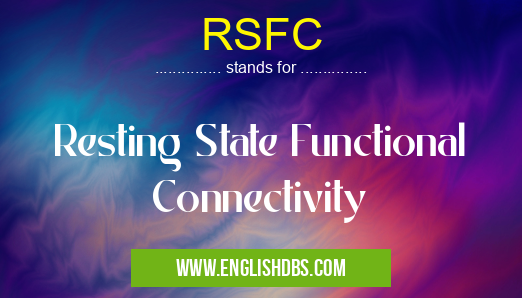What does RSFC mean in PHYSIOLOGY
Resting state functional connectivity (RSFC) is a term used in neuroscience to describe the temporal correlations between different regions of the brain during rest, or when an individual is not engaged in any particular task. RSFC is an important tool for studying baseline brain connections and changes resulting from a variety of psychological and neurological disorders.

RSFC meaning in Physiology in Medical
RSFC mostly used in an acronym Physiology in Category Medical that means Resting State Functional Connectivity
Shorthand: RSFC,
Full Form: Resting State Functional Connectivity
For more information of "Resting State Functional Connectivity", see the section below.
» Medical » Physiology
Essential Questions and Answers on Resting State Functional Connectivity in "MEDICAL»PHYSIOLOGY"
What is resting state functional connectivity?
Resting State Functional Connectivity (RSFC) refers to the synchronization of cerebral activity that occurs between different brain regions during rest. It is a measure of how closely connected different brain areas are when the brain is at rest and not actively engaged in a task or thought process. RSFC helps us understand the neural networks in action, which can be disrupted by injury/illness/disorders leading to cognitive deficits. It can also help inform treatments and therapies for such disorders.
What types of activities get measured with resting state functional connectivity?
RSFC measures the synchronization of activity that occurs between different brain regions while an individual is at rest. Examples include EEG, fMRI and PET scans, which capture patterns of activity across wide areas of the brain without requiring an active task or thought process from the participant.
How does resting state functional connectivity measure brain function?
RSFC allows researchers to measure patterns in resting state neural networks across different parts of the brain by looking for correlations between pairs of regions that keep track of one another's spontaneous activity over time. The degree to which two regions are connected can inform us about their level of collaboration while they are at rest, giving us insight into particular functions that can be affected due to injury/illness/disorders or other disturbances in normal functioning.
Is there any difference between functional connectivity and structural connectivity?
Yes, there is a difference between functional connectivity (FC) and structural connectivity (SC). FC measures how different parts of the brain work together during tasks or activities by looking for correlations in the levels of activity within each region over time; it tells us about neural network dynamics in action. Meanwhile SC examines connections between neurons based on physical pathways such as axons and dendrites connecting neurons in different areas; it gives us insight into how entire neural networks are structured as static entities regardless of varying conditions or tasks being performed.
What kind of data does resting state functional connectivity analyze?
RSFC typically utilizes non-invasive methods such as EEG, fMRI, PET scans etc., to capture patterns within large areas of the brain without requiring an active task from participants. This data then allows researchers to compare pairs of regions over time and identify correlations that suggest levels of collaboration between them while they are at rest - providing insights into their role(s) in terms of cognition, behavior and neurological functioning.
What kind of research has been done using resting state functional connectivity?
Research using RSFC has shed light on numerous neurological diseases/disorders such as Alzheimer's, Autism Spectrum Disorders (ASD), Traumatic Brain Injury (TBI), Schizophrenia etc., informing treatments, assessments and therapies intended to improve patients' quality-of-life. Furthermore it has been used to understand better various cognitive processes such as language processing, memory formation etc., helping researchers gain a greater understanding about how these processes work within healthy individuals too.
How does resting state functional connectivity differ from other forms medical imaging technology like MRI?
Whereas MRI provides images which give information about anatomy or size changes associated with certain diseases/injuries - something referred to as 'structural' information - RSFC gives information about dynamic activity occurring between regions while they are at rest - referred to as 'functional' information; helping researchers identify relationships critical for understanding forms abnormal vs normal behavior & cognition.
Can resting state functional connectiviy be used on its own?
Yes; however it often works best when paired with other forms medical imaging technology such as MRI/fMRI or PET scans — allowing researchers a wider range information & data points than could be obtained using either modality alone— enabling better assessment & diagnosis capabilities regarding injury/disease states versus healthy conditions.
Final Words:
In conclusion, understanding resting state functional connectivity helps us better comprehend normal development as well as neurological and psychiatric disorders that disrupt basic communication pathways between different regions of the brain. In combination with other types of neuroimaging studies and research methods it has already proven to be an invaluable tool for investigating healthy cognitive processes as well as abnormal ones related to complex psychological conditions.
